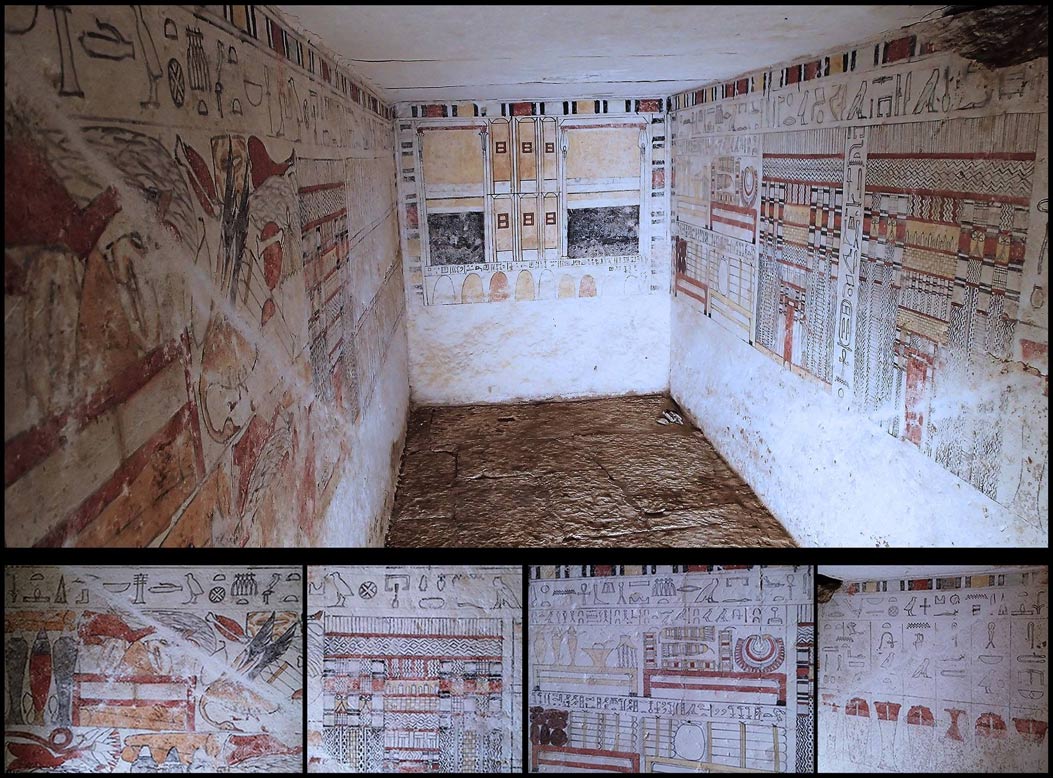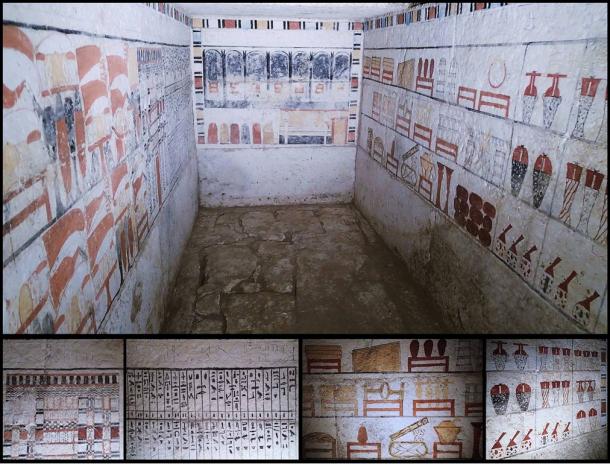Guest
Guest
 |  Subject: Archaeologists uncover 4,200-year-old Tombs of ancient Egyptian priests Subject: Archaeologists uncover 4,200-year-old Tombs of ancient Egyptian priests  Tue Apr 07, 2015 7:41 am Tue Apr 07, 2015 7:41 am | |
|  6 APRIL, 2015 - 21:58 MARK MILLERArchaeologists uncover 4,200-year-old Tombs of ancient Egyptian priestsThough the tombs of two ancient Egyptian priests excavated recently had been vandalized and their bones scattered across the burial chamber many centuries ago, beautiful paintings on the walls and some objects are intact.The paintings and some artifacts show the priests were involved in the sacred rite of mummification.The remains of the deceased were in the tombs but had been strewn about. Experts believe the Sixth Dynasty tombs from about 4,200 years ago were vandalized in the Seventh or Eighth dynasties during the 21st century BC, says The Egyptian Ministry of Antiquities Facebook page.Archaeologists found some artifacts in the tombs that had not been broken. No sarcophagi were found.MORE 6 APRIL, 2015 - 21:58 MARK MILLERArchaeologists uncover 4,200-year-old Tombs of ancient Egyptian priestsThough the tombs of two ancient Egyptian priests excavated recently had been vandalized and their bones scattered across the burial chamber many centuries ago, beautiful paintings on the walls and some objects are intact.The paintings and some artifacts show the priests were involved in the sacred rite of mummification.The remains of the deceased were in the tombs but had been strewn about. Experts believe the Sixth Dynasty tombs from about 4,200 years ago were vandalized in the Seventh or Eighth dynasties during the 21st century BC, says The Egyptian Ministry of Antiquities Facebook page.Archaeologists found some artifacts in the tombs that had not been broken. No sarcophagi were found.MORE
- Two 26th dynasty tombs unearthed in Egypt containing mummies and fascinating grave goods
- Four New Kingdom rock-hewn tombs discovered in Egypt
- Ancient tomb containing mummy and 180 figurines found in Egypt
One tomb belonged to Ankh Ti and the second to Sabi, priests who lived during the reign of King Pepi II, 2240-2150 BC, said Mamdouh Eldamaty, Egypt’s minister of antiquities and heritage. The French Oriental Archaeological Institute (IFAO), working with the Ministry of Antiquities did the excavations in Tabit El-Geish south of Sakkara.“Director of the French mission Dr.Vassil Dobrev clarified that both tombs have many offering scenes to ancient Egyptian Gods, adding that the colors of the scenes are still extraordinarily preserved,” said the Facebook page.The team found funerary tools next to the skeleton, including alabaster jars, some pottery and models of offerings made of colored limestone.“The upper part of the two tombs was built with mud brick while the burial chambers were cut into the white limestone bedrock indicating that the burial chamber of Sabi was found in a 6 m (20.7 feet) deep shaft while that of “Ankh Ti” was found in a 12 m (41.4 feet) deep shaft,” the Facebook page said.MORE
- 4,000-year-old elite tomb unearthed in Luxor
- Archaeologists find 4,000 year-old tomb of prominent doctor to pharaohs southwest of Cairo
 .ancient-origins.net/news-history-archaeology/A 4,400-Year-Old Egyptian Love Story]A 4,400-Year-Old Egyptian Love Story[/url] .ancient-origins.net/news-history-archaeology/A 4,400-Year-Old Egyptian Love Story]A 4,400-Year-Old Egyptian Love Story[/url]
The general director of the Giza Archaeological Area, Kamal Wahid said “the Ankh Ti funerary room was decorated with many scenes representing the ancient Egyptian offerings, particularly the huge jars containing the seven sacred oils essential in the resurrection process. Lists of names and quantities of offerings also appear on the left wall followed by a false door and different forms of offerings (meat, birds, bread, vegetables, roses, milk and beer … etc.)”[img=(610px,314px)]http://www.ancient-origins.net/sites/default/files/styles/large/public/offering-tablet.jpg?itok=ziIO5wr_[/img]An offering tablet of the seven sacred oils (this object was not found in the tombs but shows the hieroglyphics for the names of the oils). (Osiris.net photo) The tomb of Sabi is very similar to Ankh Ti’s tomb and has the same offering scenes and lists painted on the walls, said another official, Alaa El-Shahat, general director of the Saqara Archaeological Area.The paintings show “the pot of the seven ritual oils and the list of offerings with their names and quantities. Incense balls and copper burning incense are also depicted as well as head rests and necklaces worn by priests,” Al-Ahram newspaper reported. [img=(610px,464px)]http://www.ancient-origins.net/sites/default/files/styles/large/public/priest-tomb.jpg?itok=zCFEHd8g[/img] [img=(610px,464px)]http://www.ancient-origins.net/sites/default/files/styles/large/public/priest-tomb.jpg?itok=zCFEHd8g[/img]This photo shows the tomb of the priest known as Sabi. (Egyptian Ministry of Antiquities photo) The priests’ burial chambers apparently were arranged to reflect their professions in life. The seven sacred oils were used in preparing bodies of deceased people for burial. The oils were placed in dead people’s mouths during the opening of the mouth ceremony, says the book Ancient Egyptian Technology and Innovation by Ian Shaw (It can be read at Google Books.)“Some of the oils are known from 1st Dynasty wooden and ivory funerary labels, but the group appears not to have been used collectively until the Old Kingdom (2686-2181 BC), when they were represented as part of the offering formula on the walls or false-door stelae of tombs,” the book states. “The earliest known actual set of the seven sacred oils is from the above-mentioned tomb or reburial cache of Queen Hetepheres I at Giza. However, small stone tablets with depressions for these oils were sometimes placed in burials throughout the Old Kingdom. Examples of all these items associated with aspects of mummification have survived in the archaeological record, and in the case of psš-kf, the possible derivation of the fishtail knife suggests at least some of these posthumous rituals can be traced back to a date prior to the emergence of most of the other elements of fully developed Egyptian mummification.”A psš-kf is the fishtail knife used in the mummification ceremony. Such a knife was not found in the looted tombs of Ankh-Ti and Sabi.Featured image: Experts said the tombs, which were similar to each other, were decorated with scenes depicting ancient Egyptian offerings to deities. This is the tomb of the priest known as Ankh-Ti. (Egyptian Ministry of Antiquities photo)By Mark Miller
Read more: http://www.ancient-origins.net/news-history-archaeology/archaeologists-uncover-4200-year-old-tombs-ancient-egyptian-priests-002871#ixzz3WctjVSKm |
|





